Petroleum 30 C
Infestation of spider mites and whitefly on young lemon and mandarin trees, as
well as almonds and figs
The young trees of Ms M are overwintered in a cool, light place. Here they
regularly become infested with spider mites and whitefly in February or March.
This year they were treated daily with
Petroleum
30 C (12 pellets in 5 liters water), sprayed and watered. Improvement was seen
after 3 days, and after one week the pests had disappeared. The pots were later
returned to the balcony where they suffered no further infestation.
Petroleum 30 C: Spider mites on greenhouse cucumbers
Ms S. had sixcucumbers in her greenhouse this year. She planted
them, pre-grown in pots, at the end of April . By May she already had her first
cucumbers. As every year, they developed well until they were affected by spider
mites in June.
The affected leaves had yellow spots, caused by the
sucking action of the pests, which later became larger, until finally the entire
leaf dried out and turned brown.
In previous years, Ms S. had used beneficial
organisms (green lacewings). This somewhat reduced the infestation but without
completely eliminating it.
This year Ms S. treated the cucumbers with a
mixture of Petroleum
30 C and Psorinum
200 C, which she applied to the plants every 4 to 5 days, watering and
spraying a total of 3 applications. read
on...
The spider mite infestation improved a little but then
returned strongly again. At this stage the cucumber plants looked distinctly
unwell.
At the beginning of August, she tried Amblyseius
6 X, which is a homeopathic preparation from Gamasina mites.
She
removed the old affected leaves and watered the cucumbers 2x per week with 10 ml
of remedy solution in 10 litres of water.
To her astonishment, the cucumbers
developed new shoots, with healthy leaves and fruit, right through to the end of
September – completely free of spider mites. In previous years the cucumber
plants were finshed already in August. (Edda S., Schwaigern 2013) 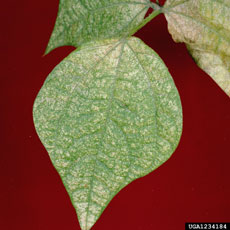
Petroleum: Eradication of Spider Mites on Hibiscus
"I had great success treating a hibiscus (house plant, not frost-hardy) with Petroleum 30 C. The plant reacted immediately – by the next day (!) it had started to differentiate between diseased leaves, which it discarded, and healthy “to be kept” leaves. The plant's vitality increased straight away. The colour changed within a few days, with more green leaves visible. After repotting as an additional measure, it is now putting out new shoots.
For me this is clearly a success application of your homeopathic remedy. Normally I have to take immediate and firm counter-measures in cases of spider mite infestation (which hibiscus is sadly prone to), either by carefully wiping the leaves by hand or by using an insecticide. Inaction leads to the most severe infestation with total loss of leaves."
Initial condition on 8th April :
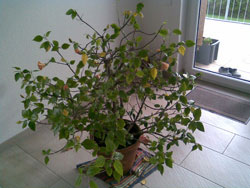
Condition on 10th April (second day after homeopathic treatment) : 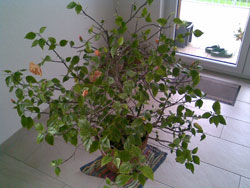
Current condition (6th May) – it was repotted just before Easter
(Good Friday) : 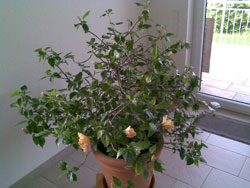
Riccarda L., 2014
 » Petroleum order » Petroleum order
Petroleum 30 C:
Attack of whitefly and spider mite on lemon and mandarin trees as well as almond and fig trees.
The small trees are brought into the house by Ms M. to overwinter in a cool and light place.
Here they are regularly infested in February or March by spider mite and whitefly.
This time they were watered and sprayed daily with Petroleum 30 C (12 pellets in 5 litres of water).
After three days there was a noticeable improvement and after a week the pests had disappeared.
The tubs were later put onto the balcony, where they were not infested again.
Kandern, Germany 2012
Aphids, whitefly and brown rot on tomatoes
Some cabbage plants showed signs of a massive infestation with whitefly. When watering, clouds of flies rose into the air. The plants were treated by watering with Petroleum 30 C (5 pellets in 5 litres of water) at an interval of 2-3 days.
The infestation declined, with only a few flies visible – no comparison to the situation before the application of the remedy.
What I could observe was that it takes some time to work. With aphids in particular, it takes about a week for them to disappear. But the effect remains and the plants seemed to be strengthened generally.
It is easy to see the dead lice. A few lice are still there but their numbers are dropping and the plant is growing back strongly.
Dominik Albert, Buchen, Germany 2014
Petroleum 30 C: grape erineum mite on grapevines & spider mites on mallow
A single 5-year-old vine with 4-5 shoots carrying fruit in the garden of Juliane W. had many "buckled" leaves – due to infestation with the grape erineum mite.
The pock-like raised areas are filled with a white to red fur on the underside of the leaves, where the sucking mites are found. At the end of May, the leaves were sprayed with a pressure sprayer filled with Petroleum 30 C, following Christiane Maute's instructions. The infestation then stopped. New leaves were healthy and the affected leaves showed no further signs of damage.
On the sea rosemallow, which Ms W. had cultivated herself and kept indoors in the winter, there was a large number of spider mites by the beginning of spring. On the undersides of many leaves, it was possible to see a coating of tiny mites as well as the typical web-like substance between the stalks and the leaves. The affected leaves dried off after a time and fell of. The subsequent use of natural or chemical substances only had a short-term effect.
At the end of April, the bush on the terrace was watered with a watering can filled with a solution of Petroleum 30 C. After 1-2 days, all the spider mites had disappeared. The treatment was repeated 14 days later and the mallow has since remained free of mites.
Julia W., Switzerland 2014
 » Petroleum order » Petroleum order
Petroleum 30 C: scale insects on lemon trees
Ms Erna B.'s three small lemon trees were overwintered in the conservatory. The undersides of the leaves were infested by scale insects, which she treated with Petroleum 30 C.
This is a tip from Christiane Maute's book: Homeopathy for Plants.
The plants were sprayed and watered several times every few days with 4 pellets in 1 litre of water. The scale insects, which normally stick to the leaves, could then be easily wiped off; they appeared to be dead. After some time there was a repeat infestation, which could be successfully treated in the same way.
In the middle of May, the trees were put out into the garden, and scale insects were again seen on the undersides of the leaves, as well as green aphids on the stems and the axils of the leaves – they were being “farmed” by ants. Erna B. now sprayed and watered the lemon trees every two days alternately with Petroleum 30 C and Staphisagria 200 C, after which the plants were free of pests after 1-2 weeks.
Erna B., Dettingen, Germany 2013
Scale insects on orange trees with Petroleum 30 C
The treatment of the troublesome scale insects on my orange trees with Petroleum 30 C has been successful for some time now, following Christiane Maute's recommendation, rather than using the conventional synthetic or rapeseed oil-based sprays. I use 6 - 8 pellets per litre of water. Initially I sprayed the plants with a plastic sprayer, but the results were not good. Since last year I have been pouring the remedy solution onto the trees with a plastic watering can with a sprinkler attachment. This may need more water but it allows the plants to take up the active agent via the roots*. This treatment can be used instead of “normal” watering with plain water.
After two treatments in one week (for example, first treatment on Sunday, second treatment on Wednesday, and – in cases of severe infestation – a third treatment on Sunday) the scale insects die off. This can be seen when the insects become dark brown and dried out on the leaves, and can be wiped off, if they have not already been knocked off by the action of rain and wind.
* Here it would be interesting to see whether other users also notice a difference between spraying and watering since the homeopathic solution is primarily absorbed by the roots with watering.
W.Seiler, Mühlenbach, Germany 2013
Petroleum 30 C – Mulberry scale insects
After the long winter, my jostaberries were affected by mulberry scale.
The trunk and some buds were covered in a chalky deposit and budding was inhibited. The mulberry scale insect is said to be difficult to treat. Due to the fruits, I wanted to avoid using a chemical spray and was afraid I would have to get rid of the plant.
Without any great expectations, I applied 3 pellets of Petroleum 30 C, which I had dissolved in water. Just three days later, the white layer was almost completely gone and the buds were forming again.
After a second dose of 3 pellets of Petroleum 30 C, the finally traces of the pest disappeared and the plant looked completely healthy.
Picture 1: the damage before treatment
Picture 2: eight days later, following two treatments
With best wishes to Christiane Maute for this marvellous book,
Birgit J.
before:

afterwards:
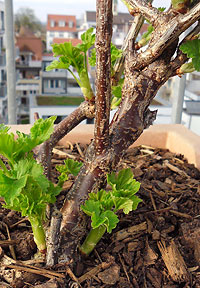
 » Petroleum order » Petroleum order
Petroleum C 30: Homeopathic Treatment of White Hairy Lice on Catalpa
Our big 2.50 metre
high "Catalpa" tree was comprehensively pruned last autumn, and the
crown was severely thinned out. This year in June large numbers of small, pale
white hairy lice appeared. At the same time, there were oily black drops all
over the leaves, spilling onto the ground (fig 1) .
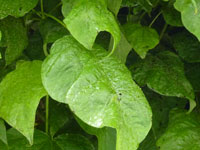 | 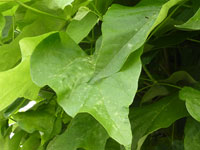 | | 22. Juni | 14. Juli |
On June 22nd the tree was treated with Petroleum 30 C
(6 pellets in 20 litres of water), poured onto the roots, and the oily
drops subsequently disappeared. But then an even stronger glistening,
sticky honey-like film appeared on the leaves and the ground beneath
the tree. Seven days after Petroleum 30 C, we applied the same dose of Sulphur 200 C
(twice, at an interval of five days). Some leaves fell off since they
had died due to the sucking action; but the lice only slowly diminished
in number. On July 9th 2015 Maute-Rundum 30 C was applied by watering
the tree with a solution of 8 pellets in 30 litres of water. The lice
then rapidly declined, and had completely disappeared by July 14th
(picture 2).
Cornelia Maute 2015
Petroleum – black aphids and red spider mites on hibiscus pot plants
"Now
I'd like to tell you about my 'successes', which leave me rather
'speechless' but in a nice way! I've got a series of large hibiscus pot
plants. Every year when I bring them back into the house, they quickly
come down with aphids. Then I give the plants 'poison capsules'. One
dose keeps the plants free of aphids the whole winter. So that's what
I've been doing with success (though not with a clear conscience!!!) for
years now. This year everything was different: one plant was covered in
black aphids (buds and flowers), and the aphids were not repelled even
by repeat doses of the poison capsules. They were constantly reproducing
but thankfully did not attack the neighbouring plants. When I got my
homeopathic remedies, I put a few pellets of Cimicifuga 30 C
in a sprayer, shook it, and sprayed my hibiscus. The next day I could
scarcely believe my eyes – the aphids were gone. I sprayed a second
hibiscus suffering infestation with red spider mites. Nothing happened!
Then I sprayed it with Petroleum 30 C
– all the spiders and their webs were gone!!!!! I can scarcely believe
it!!! I just did not reckon it would work so quickly!! Unfortunately I
didn't take any pictures – as evidence!!! Now I really hope that Helix tosta does the job for slugs – which will certainly be out in force after the mild winter!"
Mechthild K., Austria 2013
 » Petroleum order » Petroleum order
|



 2.731.680 customers from 193 countries
2.731.680 customers from 193 countries














